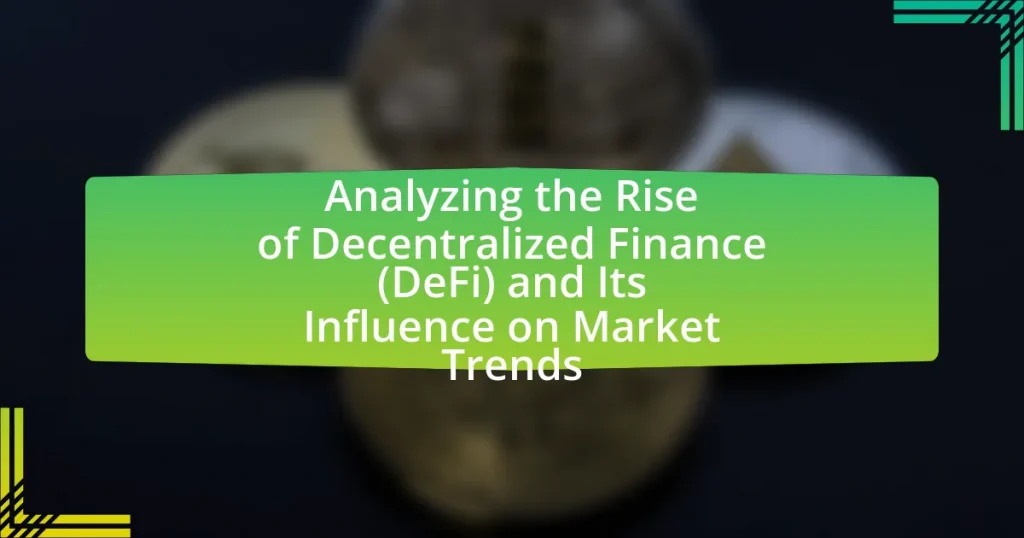Decentralized Finance (DeFi) represents a transformative financial system built on blockchain technology, enabling users to engage in various financial activities without intermediaries. This article analyzes the rise of DeFi, highlighting its key principles, components, and the role of smart contracts, while contrasting it with traditional finance. It explores the benefits and challenges of DeFi, its impact on market trends and cryptocurrency prices, and the evolving investor behavior and strategies within this ecosystem. Additionally, the article addresses regulatory challenges and future prospects for DeFi, emphasizing its potential to enhance financial inclusion and integrate with traditional financial systems.
--Decentralized-Finance-(DeFi)-refers-to-a-financial-system-buil-1.webp)
What is Decentralized Finance (DeFi)?
Decentralized Finance (DeFi) refers to a financial system built on blockchain technology that operates without central authorities or intermediaries. DeFi platforms enable users to engage in various financial activities, such as lending, borrowing, trading, and earning interest, directly through smart contracts. The rise of DeFi has been significant, with the total value locked in DeFi protocols exceeding $80 billion in 2021, demonstrating its growing influence on market trends and traditional finance.
How does DeFi differ from traditional finance?
DeFi, or decentralized finance, differs from traditional finance primarily in its reliance on blockchain technology and smart contracts, which eliminate the need for intermediaries like banks. In traditional finance, transactions are processed through centralized institutions that manage and verify transactions, whereas DeFi operates on a peer-to-peer basis, allowing users to engage directly with financial services. This decentralized approach enhances transparency, reduces costs, and increases accessibility, as evidenced by the rapid growth of DeFi platforms, which saw total value locked in DeFi protocols exceed $80 billion in 2021, according to DeFi Pulse.
What are the key principles of DeFi?
The key principles of DeFi are decentralization, transparency, permissionless access, and programmability. Decentralization ensures that no single entity controls the financial system, allowing for peer-to-peer transactions. Transparency is achieved through blockchain technology, where all transactions are publicly recorded and verifiable. Permissionless access allows anyone with an internet connection to participate in financial services without the need for intermediaries or approvals. Programmability enables the creation of smart contracts, which automate and enforce agreements without human intervention. These principles collectively foster an open financial ecosystem that enhances accessibility and innovation in financial services.
How does blockchain technology support DeFi?
Blockchain technology supports DeFi by providing a decentralized, transparent, and secure infrastructure for financial transactions. This technology enables smart contracts, which automate and enforce agreements without intermediaries, reducing costs and increasing efficiency. Additionally, blockchain’s immutable ledger ensures that all transactions are recorded transparently, enhancing trust among users. According to a report by the World Economic Forum, blockchain could potentially reduce financial services costs by up to 30%, demonstrating its significant impact on the DeFi landscape.
What are the main components of the DeFi ecosystem?
The main components of the DeFi ecosystem include decentralized exchanges (DEXs), lending platforms, stablecoins, yield farming protocols, and liquidity pools. Decentralized exchanges facilitate peer-to-peer trading of cryptocurrencies without intermediaries, while lending platforms allow users to borrow and lend assets directly. Stablecoins provide price stability by pegging their value to fiat currencies, and yield farming protocols enable users to earn rewards by providing liquidity. Liquidity pools are essential for DEXs and lending platforms, as they aggregate funds to facilitate transactions and lending activities. These components collectively contribute to the functionality and growth of the DeFi ecosystem, which has seen significant adoption and innovation in recent years.
What role do smart contracts play in DeFi?
Smart contracts are essential to DeFi as they automate and enforce agreements without intermediaries. They facilitate transactions, lending, borrowing, and trading on decentralized platforms by executing predefined conditions coded within them. For instance, in 2020, the total value locked in DeFi protocols reached over $15 billion, demonstrating the reliance on smart contracts for secure and efficient financial operations.
How do decentralized exchanges (DEXs) function?
Decentralized exchanges (DEXs) function by enabling peer-to-peer trading of cryptocurrencies without the need for a central authority. They utilize smart contracts on blockchain networks to facilitate transactions directly between users, ensuring that trades are executed automatically when predefined conditions are met. This model enhances security and privacy, as users retain control of their funds throughout the trading process. DEXs often employ liquidity pools, where users provide assets to facilitate trading, earning fees in return. According to a report by DeFi Pulse, the total value locked in DEXs has surged, reflecting their growing adoption and influence in the decentralized finance ecosystem.
What are liquidity pools and how do they operate?
Liquidity pools are collections of cryptocurrencies locked in a smart contract that facilitate trading on decentralized exchanges (DEXs). They operate by allowing users to provide liquidity, which is then used to enable trading pairs without the need for a traditional order book. When users trade assets, they pay a small fee, which is distributed among liquidity providers as an incentive for their contribution. This mechanism enhances market efficiency and reduces price slippage, making it easier for traders to execute transactions. The concept of liquidity pools is foundational to decentralized finance (DeFi), as it enables automated market-making and fosters a more accessible trading environment.
What are the benefits and challenges of DeFi?
The benefits of DeFi include increased accessibility to financial services, enhanced transparency through blockchain technology, and the potential for higher returns on investments due to the elimination of intermediaries. For instance, DeFi platforms allow users to lend, borrow, and trade assets without traditional banks, which can lead to lower fees and faster transactions. However, challenges such as regulatory uncertainty, smart contract vulnerabilities, and market volatility pose significant risks. According to a report by the World Economic Forum, the lack of consumer protection in DeFi can lead to substantial financial losses, highlighting the need for improved security measures and regulatory frameworks.
How does DeFi enhance financial inclusion?
DeFi enhances financial inclusion by providing decentralized access to financial services without the need for traditional banking infrastructure. This accessibility allows individuals in underserved regions, who may lack bank accounts or credit histories, to participate in financial activities such as lending, borrowing, and trading. According to a report by the World Bank, approximately 1.7 billion adults globally remain unbanked, highlighting the potential of DeFi to bridge this gap by enabling peer-to-peer transactions and reducing reliance on intermediaries. Furthermore, DeFi platforms often require minimal documentation, making it easier for marginalized populations to engage in the financial system.
What risks are associated with DeFi investments?
DeFi investments carry several risks, including smart contract vulnerabilities, market volatility, regulatory uncertainty, and liquidity risks. Smart contracts, which automate transactions, can contain bugs or be exploited, leading to financial losses; for instance, the DAO hack in 2016 resulted in a loss of $60 million due to a vulnerability. Market volatility can cause significant price fluctuations, impacting the value of assets held in DeFi protocols. Regulatory uncertainty poses risks as governments may impose restrictions or bans on DeFi activities, affecting the viability of projects. Lastly, liquidity risks arise when users cannot easily convert their assets into cash or other cryptocurrencies, especially during market downturns.

How has DeFi influenced market trends?
DeFi has significantly influenced market trends by increasing liquidity and enabling new financial products. The rise of decentralized finance has led to a surge in the total value locked (TVL) in DeFi protocols, which reached over $100 billion in 2021, demonstrating its impact on capital allocation in the cryptocurrency market. Additionally, DeFi has introduced innovative mechanisms such as yield farming and liquidity mining, which have attracted both retail and institutional investors, further shaping market dynamics. The growth of DeFi has also prompted traditional financial institutions to explore blockchain technology and digital assets, indicating a shift in the overall financial landscape.
What impact has DeFi had on cryptocurrency prices?
DeFi has significantly influenced cryptocurrency prices by increasing demand and market liquidity. The rise of decentralized finance platforms has led to a surge in the use of cryptocurrencies for lending, borrowing, and trading, which has driven up their prices. For instance, in 2020, the total value locked in DeFi protocols grew from $1 billion to over $15 billion, correlating with substantial price increases in major cryptocurrencies like Ethereum, which saw a rise from around $130 to over $400 during the same period. This demonstrates that the expansion of DeFi has created new use cases for cryptocurrencies, thereby positively impacting their market valuations.
How do DeFi projects affect the overall crypto market?
DeFi projects significantly influence the overall crypto market by increasing liquidity and driving innovation. These projects enable users to lend, borrow, and trade assets without intermediaries, which enhances market efficiency. For instance, the total value locked (TVL) in DeFi reached over $100 billion in 2021, demonstrating substantial capital flow into these platforms. This influx of capital often leads to increased trading volumes and price volatility across the broader crypto market, as assets are rapidly moved between DeFi protocols and traditional exchanges. Additionally, the rise of DeFi has prompted traditional financial institutions to explore blockchain technology, further integrating cryptocurrencies into mainstream finance.
What trends have emerged in DeFi token valuations?
DeFi token valuations have increasingly shown a trend towards volatility and correlation with broader cryptocurrency market movements. This trend is evidenced by the significant price fluctuations observed in major DeFi tokens like Uniswap and Aave, which often mirror the price movements of Bitcoin and Ethereum. For instance, during the market rally in early 2021, many DeFi tokens experienced price surges exceeding 100%, reflecting heightened investor interest and speculative trading. Additionally, the introduction of yield farming and liquidity mining has contributed to inflated valuations, as tokens are often rewarded for providing liquidity, leading to temporary spikes in their market prices.
How has DeFi changed investor behavior?
DeFi has significantly changed investor behavior by promoting greater participation and engagement in financial markets. Traditional barriers to entry, such as high fees and complex processes, have been reduced, allowing more individuals to invest directly in assets and protocols. For instance, as of 2021, over $80 billion was locked in DeFi protocols, indicating a shift towards decentralized platforms where investors can earn yields and trade without intermediaries. This democratization of finance has led to increased risk-taking and a preference for innovative investment strategies among retail investors, as evidenced by the rapid growth of yield farming and liquidity mining practices.
What new investment strategies are being adopted due to DeFi?
New investment strategies being adopted due to DeFi include yield farming, liquidity mining, and decentralized lending. Yield farming allows investors to earn returns by providing liquidity to DeFi protocols, often resulting in higher returns compared to traditional investments. Liquidity mining incentivizes users to contribute liquidity by rewarding them with tokens, enhancing engagement and capital flow within DeFi ecosystems. Decentralized lending enables users to borrow and lend assets without intermediaries, often at lower costs and with more flexible terms than traditional finance. These strategies reflect a shift towards more accessible and potentially lucrative investment opportunities in the decentralized finance landscape.
How has DeFi influenced the risk appetite of investors?
DeFi has significantly increased the risk appetite of investors by providing access to high-yield opportunities and innovative financial products. This shift is evidenced by the rapid growth of DeFi platforms, which saw total value locked (TVL) in DeFi protocols rise from approximately $1 billion in early 2020 to over $100 billion by late 2021, indicating a strong interest in riskier investments. Additionally, the ability to earn substantial returns through yield farming and liquidity mining has attracted both retail and institutional investors, encouraging them to engage in more speculative trading and investment strategies.
What regulatory challenges does DeFi face?
Decentralized Finance (DeFi) faces significant regulatory challenges primarily due to its lack of centralized control and the anonymity of its participants. Regulatory bodies struggle to apply existing financial regulations to DeFi platforms, which often operate outside traditional financial systems. For instance, the U.S. Securities and Exchange Commission (SEC) has expressed concerns regarding the classification of tokens and whether they should be treated as securities, complicating compliance for DeFi projects. Additionally, issues related to anti-money laundering (AML) and know-your-customer (KYC) regulations arise, as many DeFi platforms do not require user identification, making it difficult for regulators to monitor illicit activities. These challenges highlight the ongoing tension between innovation in DeFi and the need for regulatory oversight to protect investors and maintain market integrity.
How are governments responding to the rise of DeFi?
Governments are responding to the rise of DeFi by implementing regulatory frameworks aimed at addressing risks associated with decentralized finance. For instance, the European Union has proposed the Markets in Crypto-Assets (MiCA) regulation, which seeks to create a comprehensive regulatory environment for cryptocurrencies and DeFi platforms. Similarly, the U.S. Securities and Exchange Commission (SEC) has increased scrutiny on DeFi projects, emphasizing the need for compliance with existing securities laws. These actions reflect a growing recognition of the need to balance innovation in DeFi with consumer protection and financial stability.
What potential regulations could impact DeFi’s growth?
Potential regulations that could impact DeFi’s growth include anti-money laundering (AML) and know your customer (KYC) requirements, which may impose strict compliance obligations on DeFi platforms. These regulations aim to prevent illicit activities and ensure transparency, but they could hinder the decentralized nature of DeFi by requiring user identification and transaction monitoring. Additionally, securities regulations may classify certain DeFi tokens as securities, subjecting them to registration and disclosure requirements, which could limit innovation and accessibility. The Financial Action Task Force (FATF) has also recommended that countries regulate virtual assets, influencing national policies that could further restrict DeFi operations.

What are the future prospects of DeFi?
The future prospects of DeFi indicate significant growth and integration into traditional finance systems. As of 2023, the total value locked in DeFi protocols has surpassed $100 billion, showcasing increasing user adoption and investment. Furthermore, advancements in interoperability and scalability solutions, such as Layer 2 technologies, are expected to enhance DeFi’s efficiency and user experience. The ongoing regulatory developments also suggest that as frameworks become clearer, institutional participation in DeFi will likely increase, further legitimizing the sector.
How might DeFi evolve in the coming years?
DeFi is likely to evolve through increased regulatory clarity, enhanced interoperability, and the integration of traditional finance. Regulatory frameworks are expected to emerge, providing guidelines that will foster innovation while ensuring consumer protection. Enhanced interoperability among different DeFi platforms will facilitate seamless transactions and broaden user access, as evidenced by the growing number of cross-chain protocols. Additionally, the integration of traditional financial services, such as lending and insurance, into DeFi platforms will attract a wider audience, as seen in the rise of DeFi lending protocols that mimic traditional banking services.
What technological advancements could enhance DeFi?
Technological advancements that could enhance DeFi include improved interoperability protocols, enhanced security measures, and the integration of artificial intelligence. Interoperability protocols, such as Polkadot and Cosmos, enable different blockchain networks to communicate, facilitating seamless asset transfers and liquidity sharing. Enhanced security measures, including advanced cryptographic techniques and decentralized identity solutions, can mitigate risks associated with hacks and fraud, which have historically plagued DeFi platforms. The integration of artificial intelligence can optimize trading strategies and risk assessment, allowing for more efficient market operations. These advancements are supported by the growing adoption of cross-chain solutions and the increasing focus on security in the blockchain space, evidenced by the rise in funding for security-focused startups in the DeFi sector.
How could DeFi integrate with traditional financial systems?
DeFi could integrate with traditional financial systems through the use of blockchain technology to enhance transparency and efficiency in transactions. By leveraging smart contracts, DeFi platforms can automate processes such as lending, borrowing, and trading, reducing the need for intermediaries like banks. This integration can be evidenced by initiatives such as the collaboration between traditional banks and DeFi projects, which aim to offer customers seamless access to decentralized financial services while maintaining regulatory compliance. For instance, some banks are exploring partnerships with DeFi protocols to provide customers with decentralized lending options, thereby expanding their service offerings and improving customer engagement.
What are the best practices for engaging with DeFi?
The best practices for engaging with DeFi include conducting thorough research, using reputable platforms, diversifying investments, and implementing strong security measures. Engaging with DeFi requires understanding the underlying protocols and risks associated with decentralized finance. Researching projects, their teams, and community feedback helps in identifying trustworthy platforms. Utilizing well-established DeFi platforms reduces the risk of scams and vulnerabilities. Diversifying investments across various DeFi projects mitigates risk exposure. Additionally, employing security practices such as using hardware wallets and enabling two-factor authentication protects assets from potential threats. These practices are essential for navigating the rapidly evolving DeFi landscape effectively.
How can investors safely navigate the DeFi landscape?
Investors can safely navigate the DeFi landscape by conducting thorough research, utilizing reputable platforms, and implementing risk management strategies. Researching projects involves analyzing whitepapers, team backgrounds, and community feedback to assess credibility. Utilizing reputable platforms ensures that investors engage with established protocols that have undergone audits and have a track record of security. Implementing risk management strategies, such as diversifying investments and setting stop-loss orders, helps mitigate potential losses. According to a report by the Blockchain Security Alliance, over $1.4 billion was lost to hacks and exploits in DeFi in 2021, highlighting the importance of security measures and due diligence in this space.
What resources are available for learning about DeFi?
Resources available for learning about DeFi include online courses, educational websites, and community forums. Platforms like Coursera and Udemy offer structured courses on decentralized finance, while websites such as DeFi Pulse and CoinGecko provide up-to-date information and analytics on DeFi projects. Additionally, community forums like Reddit and Discord host discussions and insights from experienced users, enhancing understanding through shared knowledge. These resources collectively support comprehensive learning about DeFi, its mechanisms, and its market impact.
It is not possible to provide an answer to the question “
” as it does not contain a specific inquiry or context to address.






